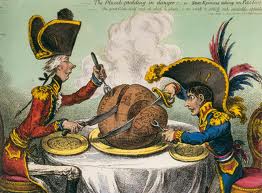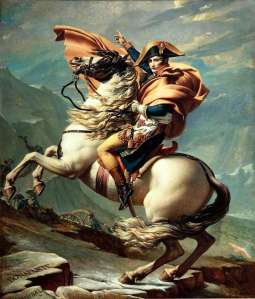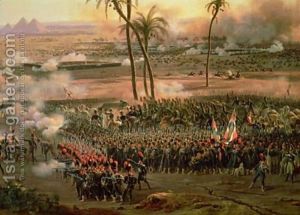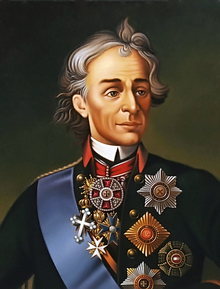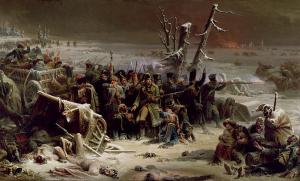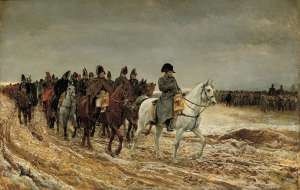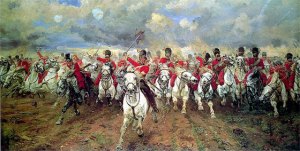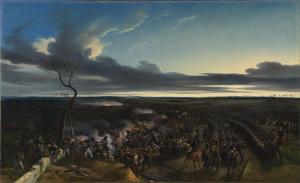Choosing to do Project Montmirail followed a similar decision making path as prior projects. A number of factors came into play, a discussion of which follows:
Battle size – for some reason, I gravitate toward building an entire engagement where possible, rather than just a generic force or small portion of a larger battle. Part of this comes from living in a smaller community, which necessitates doing both sides of any engagement. The other is likely more a psychological hangup in wanting things to be “complete” and all inclusive. Hence my Rorke’s Drift instead of some generic colonials, Waterloo totally done, Rivoli instead of just 1796-97, etc. I tend to want to do entire OOBs and spend some time on research. Of course my wallet then dictates that I can’t do all of Leipzig, so smaller battles have more appeal.
Montmirail involved around 18,000 Russians, 18,000 Prussians and 20,000 French. As Yorck was reluctant to engage initially, about 1/2 of his foot could not have reasonably impacted the battle, which brings the total OOB down several thousand men. In addition, the Cossacks were off somewhere else, and that saves on Russian horse. The muddy conditions also mean some Allied cannon can be avoid in the OOB, since Yorck couldn’t get the heavy guns up. This initial small size and these historical reductions starts to make buying and painting the necessary figures more within the limits of the pocket book.
Also the geographic area covered allows the entire battle to be fought of a reasonably sized table. Practical experience tends to teach that 6 feet is about as wide as you can make a table and still reach the middle. An extra 2-3 feet can be added as limited places to the width. Length is really only limited by the size of your room. I tend to use standard 3×6 foot tables, and 18×6 is pretty good. Montmirail can fit within these parameters.
Time Period – I have French Revolution and Waterloo covered. The period of Austerlitz to Jena is not all that interesting to me, as it saw Napoleon pretty much just kicking everyone around. Eylau to Friedland are less one sided, and a game in the snow make Eylau appealing. But those are large engagements beyond my ability at battalion scale and 28mm. 1809 is France vs Austria, and that’s too close to my Napoleon in Italy project; I’ve got the Blue vs White already. Also Montmirail has both Prussians and Russians, so with some modification I can do lots of things in the 1813-14 period, actual and hypothetical, with the OOB.
Figure Availability – This probably got me started on Montmirail first. I came across MMPS “ready-made” painting service and it gave me some thought. The Perry plastics are nice. MMPS has a lot of expertise in uniforms of the period, so there is less need for uniform research. MMPS also has the turnaround time to get it all done and the price is reasonable. Looking from there, Perry metal figs allow the French OOB to be filled out, with the only thing missing being the Guard Scouts. Calpe lead, Perry lead and Warlord plastics allow filling out all the Prussian and Russian needs (although it looks like I will use a few Elite figs for Russian foot command, and perhaps Elite and Front Rank for some mounted commanders all around). All figure lines are top quality. I’d heard a lot for years about Calpe’s quality, and this seemed as good a reason as any to try them out. Only other thing missing at the moment are Russian Hussars, and I am looking at Elite or Front Rank for those, but will likely await the Perry releases shown on their metal Workbench.
The Need for Research – Add a French translation guide and Louis Berlange’s Montmirail website is everything you need to start on a Montmirail project. The map is done, and but for some strength estimates, the OOB is done. Uniformology is also widely available (particularly since MMPS has done a lot of that for me already).
What’s Special About the Situation? – First, this period in 1814 is stated by all to be one of Napoleon’s best performances. Then you have the Old Guard present and fighting from the start in the front line. The other similar battle is Hanau, but that would mean Bavarians and more Austrians (again, I have enough white figs). I’ve played Waterloo and watched the Guard sit around and look nice. In other games the Guard gets involved only for the coup de grace. At Montmirail the Guard was the French army. 90% of the horse was Guard. Over 50% of the foot and artillery was Guard. Finally, Napoleon and Ney are personally present, and I want to have both those figs painted.

1st Bn, 1st Regt, Old Guard Grenadiers (Victrix Plastics – MMPS)
9 battalions of French Ligne and 5 battalions of Legere were engaged at Montmirail. Most were severely understrength, some below or near 100 men. However, in building the OOB, all 14 battalions will be built at 18-figures. When playing the historical game I can either consolidate the battalions into 500 man converged units, or use only 1 or 2 stands per battalion as Carnage & Glory II is going to be keeping track of strengths per man. The full 14 battalions at 18-figures will allow me to deploy up to 7,000 French regulars in other potential 1813-14 engagements. Really the only thing missing are Cuirassier heavy cavalry.
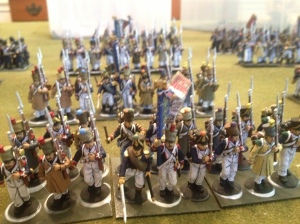
French Ligne Battalion (Perry plastics – MMPS)
The Coalition OOB is also very diverse and will give a wide range of options for other gaming in 1813-14.
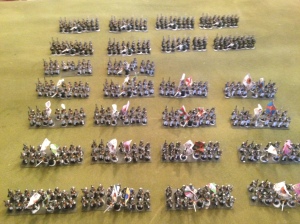
The complete Russian foot cohort (Perry plastics – MMPS)
The Russian command is a 4 1/2 infantry divisions composed of 18 Musketeer and 8 Jager battalions. Two divisions of horse are also available, including 4 regiments of Hussars and Dragoons each. Cossacks are also available if desired (they historically were not present at the battle.) Again, the only thing missing are Cuirassier.
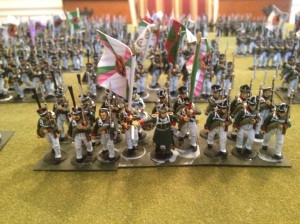
Russian Musketeer Battalion (Perry plastics – MMPS)
The Prussians are also a diverse group. Grenadier battalions, a full Line regiment with Fusilier and Musketeer battalions. 12 battalions of Landwehr foot, plus Landwehr horse, Foot and horse artillery, and the gambit of other horse – Uhlans, Dragoons and Hussars (including the Deaths Head regiment).
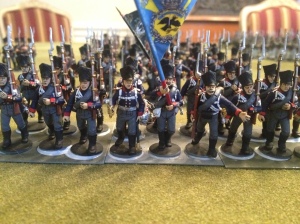
Prussian Grenadier Battalion (Perry plastics – MMPS)
So Montmirail has all lot of appealing components. The figure count is within my budget, and I can do the entire OOB. It can all fit on one big table. Filling out the French Ligne and Legere allows for additional hypothetical engagements. Full and diverse Prussian and Russian corps give a lot of variation and options. And I get a real reason to paint up Old Guard.






